Selecting the right productivity planner is crucial for enhancing your efficiency and reaching your objectives. Start by defining your goals, distinguishing between short-term tasks and long-term aspirations, which can guide your planner choice. Understand the different types available, such as daily, weekly, or bullet journals, tailoring your selection to your workflow preferences. Consider layout styles and necessary features like goal tracking or time blocking to suit your needs. Portability matters too, especially for those on the go. With careful evaluation of options—including price and user reviews—you can find a planner that aligns perfectly with your goals and lifestyle. Further insights await you.
Key Takeaways
- Define your goals using SMART criteria to clarify both short-term and long-term objectives for effective productivity planning.
- Choose a planner type (daily, weekly, goal-setting, or bullet journal) that aligns with your workflow preferences and lifestyle.
- Consider layout preferences, including daily, weekly, or monthly formats, and select designs that accommodate your writing style and visual needs.
- Evaluate essential features like goal setting, time blocking, and progress tracking to enhance your overall productivity experience.
- Assess size and portability to ensure the planner fits seamlessly into your daily routine and travel needs.
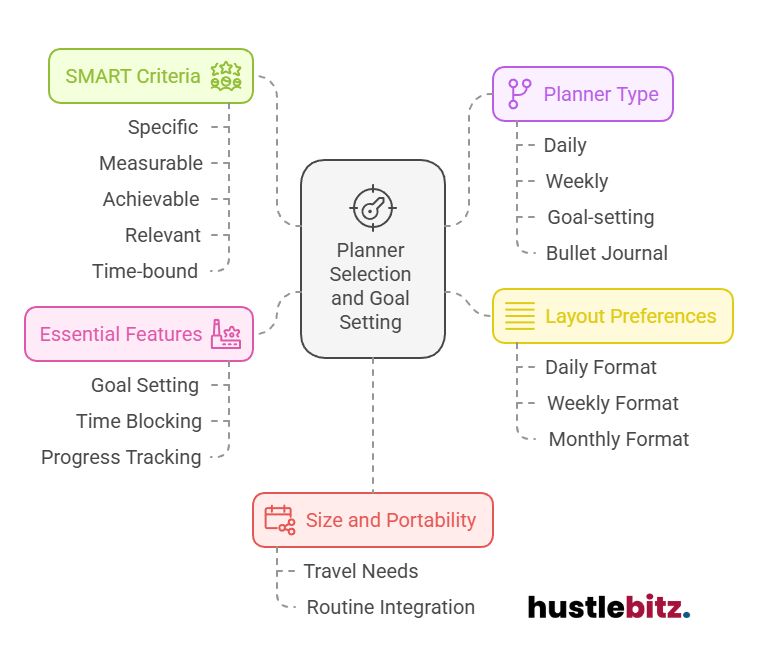
Define Your Goals
Defining your goals is the foundational step in selecting a productivity planner that aligns with your specific needs and aspirations. Goal setting is not merely about identifying what you want to achieve; it involves a deep understanding of your priorities, values, and the motivations that drive your daily actions. Whether you aim to enhance your professional efficiency, improve personal habits, or balance multiple responsibilities, a clear articulation of your goals provides the roadmap necessary for success.
To effectively define your goals, start by categorizing them into short-term and long-term objectives. Short-term goals may include daily tasks or weekly projects, while long-term goals often encompass broader aspirations, such as career advancement or personal development. This distinction helps you create a structured approach within your productivity planner, allowing for incremental progress towards achieving your goals.
Additionally, consider employing the SMART criteria—specific, measurable, achievable, relevant, and time-bound—when articulating your productivity goals. This framework ensures that your goals are not only clear but also attainable within a defined timeframe, which enhances motivation and accountability.
Ultimately, the right productivity planner should facilitate your goal-setting process. It should offer tools and features that enable you to track progress, reflect on achievements, and adjust your strategies as needed. By defining your goals with precision and clarity, you set the stage for effectively utilizing a productivity planner to achieve your aspirations.
Understand Different Planner Types

Understanding the various types of productivity planners available is essential for selecting one that best fits your individual workflow and organizational preferences. Each planner type offers unique features that cater to specific needs, particularly in areas such as daily planning, task management, and goal-setting.
Here are four common planner types to consider:
- Daily Planners: These planners focus on day-to-day activities, allowing users to allocate time slots for specific tasks. Ideal for those who thrive on structured schedules, daily planners help enhance time management and keep distractions at bay.
- Weekly Planners: Aimed at providing a broader overview, weekly planners allow users to see a snapshot of their week at a glance. This format is beneficial for individuals who prefer a balance between detailed daily planning and a more general view of their commitments.
- Goal-Setting Planners: These planners emphasize long-term objectives and strategies for achieving them. They often include sections for tracking progress, making them suitable for those focused on personal and professional growth.
- Bullet Journals: Offering a customizable format, bullet journals allow users to create their own layout and organization style. This type is perfect for creative individuals who want flexibility in both task management and daily planning.
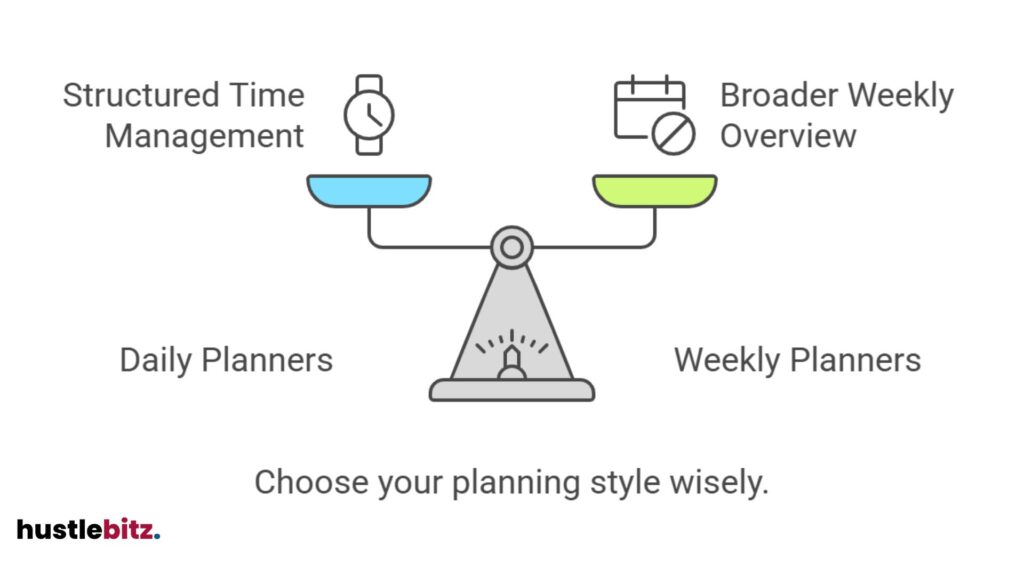
Consider Layout Preferences

When selecting a productivity planner, personal layout preferences play a crucial role in ensuring that the planner effectively supports your organizational style and daily routines. The layout of a planner can significantly impact your ability to use a productivity planner efficiently, as it dictates how you visualize and manage your time.
One of the primary considerations is whether you prefer a daily planner, weekly planner, or monthly planner layout. Daily planners allow for detailed scheduling, which can be beneficial for individuals with packed schedules or specific time management needs. Conversely, weekly and monthly layouts provide a broader view, enabling you to plan longer-term goals alongside daily tasks.
Additionally, consider the structure within each layout. Some planners offer lined sections for notes, while others may include bullet points or blank spaces for creative freedom. The choice between a minimalist design and a more elaborate, illustrated layout often depends on your personal style and the level of visual stimulation you find motivating.
Furthermore, think about how much space you need for each entry. If you find yourself writing extensive notes or reflections, a planner with ample writing space will serve you better.
Ultimately, the best productivity planner is one that aligns with your layout preferences, making it easier to integrate into your daily life. By taking the time to assess these preferences, you can enhance your time management skills and ensure that your chosen planner becomes a valuable tool in your productivity journey.
Evaluate Features and Tools
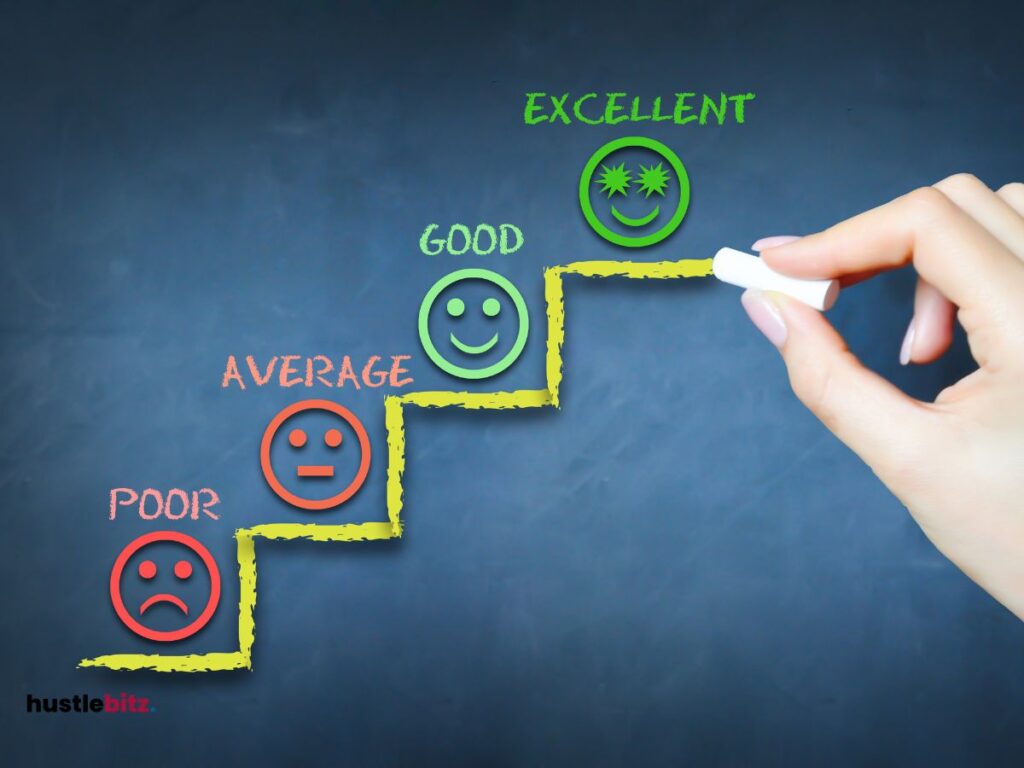
Evaluating the features and tools of a productivity planner is essential to ensure it meets your specific organizational and time management needs. A well-chosen planner can significantly boost productivity, helping you stay focused on your goals.
To find one that works for you, consider the following key features:
- Goal Setting: Look for planners that incorporate sections for long-term and short-term goal setting. This can help you maintain clarity on what you want to achieve.
- Time Blocking: A planner that allows for time blocking can enhance your ability to allocate specific hours for tasks, ensuring that you dedicate time to what matters most.
- Progress Tracking: Tools that enable you to track your daily, weekly, or monthly progress can provide insights into your productivity patterns. This feature allows you to adjust your strategies as needed.
- Customization Options: The right planner should offer flexibility in terms of layout and design. This personalization can make your planning process more enjoyable and aligned with your style.
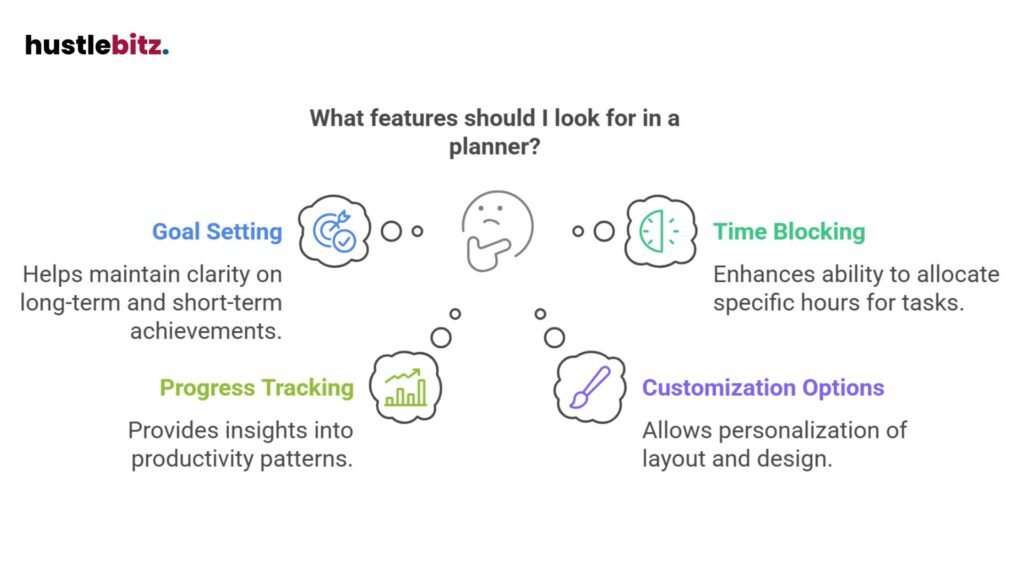
Assess Size and Portability

Assessing the size and portability of a productivity planner is crucial, as these factors determine how easily you can carry it and integrate it into your daily routine. The best planner should fit seamlessly into your lifestyle, allowing you to access it whenever needed. Consider your daily tasks and how often you will need to refer to your planner throughout the day.
A compact planner can easily fit into a handbag or backpack, making it an ideal choice for those who are frequently on the go. If you find yourself traveling often or commuting, a lightweight and slim design can help you stay organized without adding unnecessary bulk. On the other hand, if you primarily use your planner at a desk, a larger size may offer additional space for writing and detailed planning.
Additionally, evaluate the binding and cover material, as these aspects influence portability. A flexible cover can withstand the rigors of daily transport, while a hardbound planner may be more durable but less portable. The size and portability of your productivity planner should align with your personal habits and preferences, ensuring it is a practical tool rather than an inconvenience.
Ultimately, choosing the right size and portability will enhance your ability to manage daily tasks effectively. Whether you prefer a pocket-sized planner or a larger format, selecting one that accommodates your lifestyle will set you up for success in achieving your productivity goals.
Choose Between Digital or Paper
Deciding between a digital or paper productivity planner requires careful consideration of your personal preferences and how each format aligns with your organizational needs. Each option offers unique advantages that can enhance your productivity system and help you effectively manage your task lists.
- Accessibility: A digital planner allows you to access your tasks and monthly planner from multiple devices, ensuring that your productivity system is always at your fingertips. This convenience is particularly beneficial for those who are frequently on the move.
- Customization: Digital planners often come with features that let you tailor your task lists with ease. You can add, edit, or delete tasks quickly, and many apps offer reminders to help you track your progress toward deadlines.
- Simplicity in Tracking: With a digital planner, you can use built-in analytics to monitor your productivity over time. This feature can provide insights into your habits, helping you identify areas for improvement.
- Tactile Experience: On the other hand, a paper planner provides a tactile experience that many users find satisfying. Writing by hand can enhance memory retention and creativity, making it a preferred choice for those who appreciate a more traditional approach.
Ultimately, the decision between a digital planner and a paper planner hinges on your lifestyle, preferences, and how you best organize your tasks. Evaluating these factors will guide you to the most effective tool for enhancing your productivity.
Look for Customization Options

When selecting a productivity planner, it’s essential to explore the available customization options that can tailor the tool to your specific needs and preferences. A productivity planner should not only serve as a scheduling tool but also align with your personal and professional goals. Customization options can significantly enhance your experience, allowing you to structure your planner in a manner that best suits your workflow.
Consider planners that offer various layouts—such as daily, weekly, or monthly formats—that can help you stay on track with your tasks. Some planners provide the flexibility to choose between lined, grid, or blank pages, which can cater to your writing style or organizational preferences. Furthermore, the ability to select specific sections, such as goal-setting pages, habit trackers, or project planning sheets, can help you achieve a more comprehensive view of your objectives.
Additionally, look for planners that allow you to incorporate your branding or personal touches, such as custom covers or inserts. This personalization can increase your motivation when using a planner, making it a more enjoyable experience.
Ultimately, the right customization options can transform a standard productivity planner into a powerful tool tailored specifically for you, enabling you to stay focused and productive throughout your day. By ensuring that your planner reflects your unique needs, you can maximize its potential to help you achieve your goals effectively.
Review Price and Budget

Understanding the customization options of a productivity planner can lead to a more effective selection process, particularly when considering the price and budget that align with your financial goals.
When you set out to review price and budget, it is essential to keep in mind that productivity planners often vary significantly in terms of cost and features. Here are four key points to consider:
- Determine Your Budget: Establish how much you are willing to spend on a productivity planner. This will help narrow down your options and prevent overspending.
- Evaluate Features vs. Cost: Analyze the features that are most important to you. Some planners may offer unique functionalities that justify a higher price, while others may meet your needs at a lower cost.
- Look for Discounts or Bundles: Many retailers offer discounts or bundled deals. Keep an eye out for seasonal sales or promotions that may allow you to purchase the right productivity planner at a lower price.
- Consider Long-term Value: A more expensive planner may offer better quality or features that can enhance your time management over the long term. Assess whether the investment aligns with your goals to manage your time effectively.
Read User Reviews

Reading user reviews is crucial for gaining insights into the effectiveness and usability of a productivity planner before making a purchase. Reviews from actual users provide valuable perspectives that can help you determine which planner aligns best with your personal and professional goals. By examining these testimonials, you can gauge how well a specific planner will help in organizing tasks, setting priorities, and enhancing overall productivity.
When you read user reviews, pay attention to common themes and specific features that users highlight. For instance, some users may emphasize the planner’s layout, while others might focus on its goal-setting capabilities or ease of use. This information is instrumental in helping you choose the right productivity planner for your needs.
Additionally, consider the demographics of the reviewers. A planner that works well for a student may not necessarily be the best productivity tool for a busy professional. It is essential to identify a product that resonates with your lifestyle and workflow.
Moreover, user reviews can reveal potential drawbacks or limitations of a planner, enabling you to make a more informed decision. After all, a planner that has received numerous positive reviews for its functionality and design may still fail to meet your specific requirements.
Test Before Committing
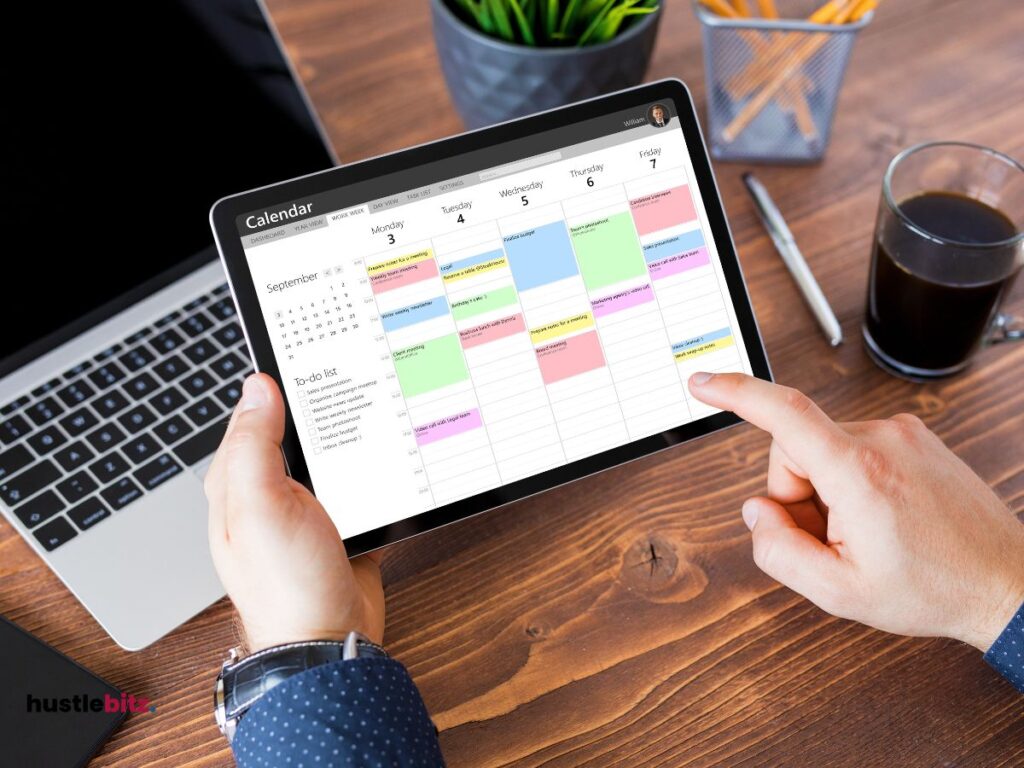
Testing a productivity planner before making a commitment can significantly enhance your likelihood of finding a tool that truly meets your needs. By taking the time to evaluate various options, you can determine which planner aligns best with your goals and work style.
Here are four essential steps to consider when you’re looking to choose the right productivity planner:
- Assess Features: Identify the specific features that matter most to you. Whether it’s daily layouts, goal-setting pages, or habit trackers, ensuring the planner gives you the functionalities you need is crucial.
- Trial Period: Many planners offer a trial period or sample pages. Utilize these to get a real sense of how the planner fits into your daily routine. Testing a planner isn’t just about aesthetics; it’s about functionality and usability.
- Flexibility in Layout: Consider how flexible the planner is to adapt to your evolving needs. A rigid planner may not help you be more productive if it doesn’t accommodate changes in your schedule or priorities.
- Gather Feedback: If possible, share the planner with colleagues or friends and gather their feedback. Sometimes, an external perspective can highlight pros or cons you may have overlooked.
Final Thoughts
Choosing the right productivity planner is a personal journey that requires careful consideration of your goals, preferences, and daily routines. By defining your objectives, understanding different planner types, and evaluating features, you can select a planner that enhances your productivity and aligns with your lifestyle. Don’t forget to assess size, portability, and customization options to ensure the planner fits seamlessly into your life. Additionally, considering your budget and reading user reviews can provide valuable insights. Finally, testing a planner before committing allows you to find the perfect tool to help you stay organized, focused, and on track to achieve your goals.




